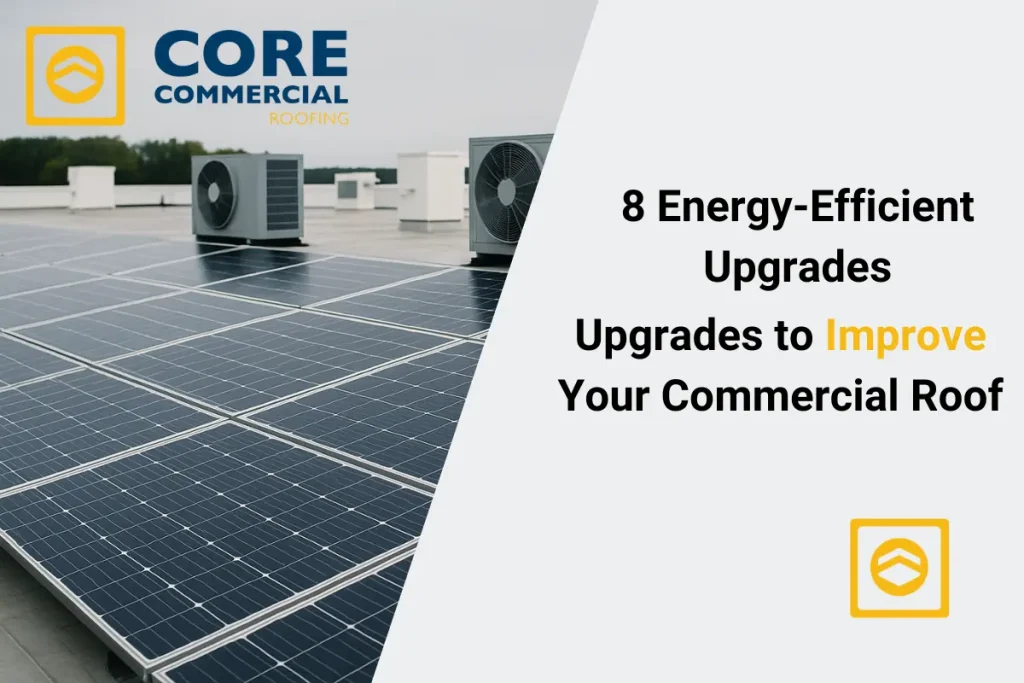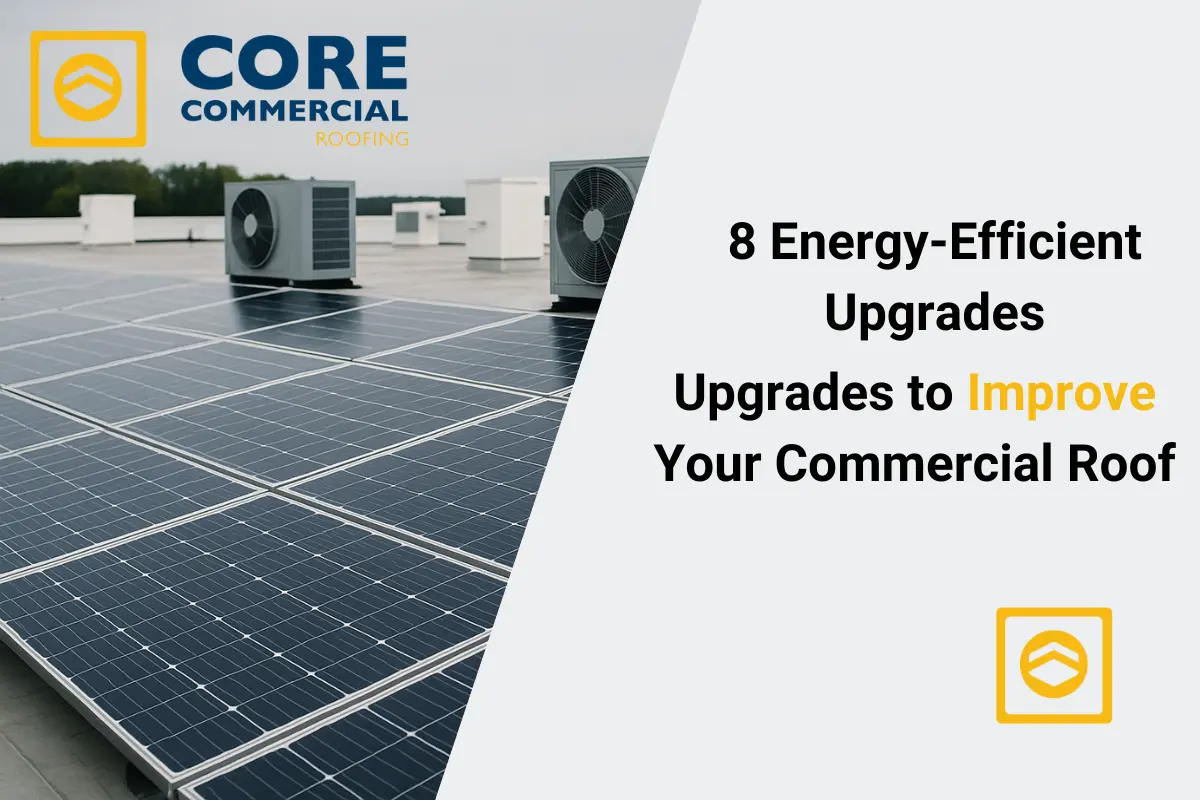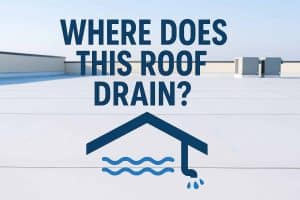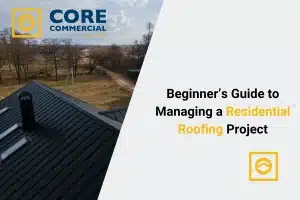Energy costs are one of the largest ongoing expenses for any business, and in many cases, the commercial roof plays a bigger role than most owners realize. A poorly insulated, dark, or outdated roof can push HVAC systems to their limits and leave employees uncomfortable. The good news is that energy-efficient upgrades can change that.
Among the many improvements available, cool roof coatings remain a favorite because they offer quick results, extending roof life while cutting energy use at the same time. When combined with other smart strategies like better insulation, ventilation upgrades, and solar integration, the result is a roof that works harder for your business instead of against it. If you’ve ever wondered how to lower energy bills, protect your roof investment, and create a more comfortable space, these eight upgrades will give you a clear path forward.

Table of Contents
Why Energy Efficiency on Your Roof Matters
For many businesses, the roof is one of the most overlooked parts of the building when it comes to energy performance. Yet, it’s also one of the biggest sources of heat gain in summer and heat loss in winter. Without the right upgrades, HVAC systems are forced to work harder, utility costs rise, and the roof itself wears down faster than it should.
Energy-efficient upgrades offer solutions that directly target these problems. Instead of simply repairing damage as it appears, building owners can take steps to prevent roof leaks, strengthen insulation, and extend the lifespan of their system. Many commercial roof types can be retrofitted with modern coatings, solar panels, or added insulation, making them more efficient without requiring full replacement.
Another reason efficiency matters is cost predictability. Businesses can better manage expenses when their buildings use less energy and reduce dependency on unstable utility rates. Some improvements may also qualify for tax credits or utility rebates, turning an upgrade into a financial advantage.
Install Reflective or Cool Roof Coatings
What It Is
Cool roof coatings are specialized materials designed to reflect more sunlight and absorb less heat than a standard roof surface. These coatings are often white or light in color and made from materials like silicone, acrylic, or elastomeric compounds.
Why It Matters
By reflecting UV rays and solar heat, cool roof coatings lower roof surface temperatures by as much as 50°F. That means less heat transfer into the building and less strain on air conditioning systems.
Real Benefits
- Cuts summer cooling costs
- Lowers roof surface temperatures for better comfort inside
- Extends the life of roofing membranes by reducing thermal stress
- May qualify for local cool roof rebate programs
- Simple application compared to a full roof replacement
Among all upgrades, this is one of the fastest ways to see measurable results.
Upgrade to Energy-Efficient Roofing Materials
What It Is
Not all commercial roof types are equal when it comes to performance. Older materials like dark asphalt and tar are known for heat absorption. By contrast, options like metal roofing, TPO (thermoplastic polyolefin), and PVC membranes are designed for reflectivity and durability.
Why It Matters
Switching materials during replacement can immediately improve a building’s energy efficiency. In addition, some materials like metal are recyclable, making them both eco-friendly and long-lasting.

Real Benefits
- Improved insulation and reflectivity
- Fire-resistant properties may reduce insurance costs
- Lower overall maintenance compared to traditional systems
- Potential installation over existing roofs, reducing disposal fees
- Adds long-term property value
When researching commercial roof cost per square foot, keep in mind that upfront investment varies by material but often pays off in reduced energy and repair costs.
Add High-Quality Roof Insulation
What It Is
Insulation acts as a barrier that slows heat flow. Options include polyisocyanurate (polyiso), EPS (expanded polystyrene), and spray foam. Proper insulation levels, measured by R-value, keep buildings warmer in winter and cooler in summer.
Why It Matters
Without proper insulation, even the best roof coating won’t prevent energy loss. Adding or upgrading insulation improves comfort and reduces HVAC load.
Real Benefits
- Lower year-round utility bills
- More stable indoor temperatures
- Improved energy performance ratings
- Long-term savings as insulation pay for themselves over time
Many property managers consult a roofing inspection checklist to determine if insulation has settled, deteriorated, or needs replacement.
Improve Roof Ventilation Systems
What It Is
Ventilation systems move air in and out of attic or roof cavities, preventing heat buildup and moisture accumulation.
Why It Matters
Poor ventilation creates hot spots, reduces insulation effectiveness, and increases the risk of condensation damage.
Real Benefits
- Keeps indoor air quality healthier
- Prevents mold, mildew, and condensation damage
- Reduces strain on HVAC units
- Saves energy in both hot and cold weather
Good ventilation goes hand-in-hand with insulation—together they provide balance for long-term roof health.
Use Light-Colored Roofing Surfaces
What It Is
Roof color has a surprising impact on performance. Light shades like white, tan, and light gray reflect sunlight better than dark materials.
Why It Matters
Just as wearing a black shirt on a sunny day makes you hotter, a dark roof absorbs more heat. Choosing lighter surfaces helps regulate indoor temperatures naturally.
Real Benefits
- Lower cooling costs in summer
- Meets local energy code requirements more easily
- Creates a cleaner, more modern roof appearance
- Reduces thermal expansion that leads to cracks and leaks
When combined with other steps to prevent roof leaks, lighter roofing surfaces can extend the system’s lifespan while lowering costs.
Consider Green Roofs or Rooftop Gardens
What It Is
Green roofs use vegetation planted over a waterproofing system. They provide both natural insulation and stormwater management.
Why It Matters
These roofs help reduce urban heat islands, improve air quality, and protect the underlying roof from UV exposure.
Real Benefits
- Excellent natural insulation
- Extended roof life by reducing UV damage
- Reduces stormwater runoff
- Enhances building image and property value
Although installation costs are higher, green roofs can offer financial and environmental payoffs in the long run.
Install Solar Panels or Solar Shingles
What It Is
Solar technology allows businesses to generate electricity directly from sunlight. Panels are mounted onto the roof, while solar shingles integrate directly into the surface.
Why It Matters
Solar reduces dependency on grid power, lowers operating costs, and supports corporate sustainability goals.
Real Benefits
- Reduces energy bills
- Potential to sell excess power back to utilities
- Eligible for tax incentives and rebates
- Increases property value
This upgrade pairs well with energy-efficient roofing materials, turning your roof into a power-generating asset.
Conduct Regular Roof Maintenance & Infrared Scans
What It Is
Regular inspections and infrared scans detect hidden leaks, weak spots, and insulation gaps before they escalate.
Why It Matters
Even the best upgrades fail if the roof isn’t maintained. A small leak or moisture pocket can quickly undo efficiency gains.
Real Benefits
- Prevents costly water damage
- Ensures insulation and coatings function properly
- Extends roof lifespan
- Improves performance in energy audits
Following a roofing inspection checklist at least twice a year keeps issues manageable and budgets predictable.
Final Thoughts: Energy Efficiency Is a Smart Investment
Investing in energy-efficient roof upgrades is about more than lowering bills—it’s about protecting your building, extending the life of your roof, and creating a healthier indoor environment. Whether it’s applying a reflective coating, upgrading insulation, or installing solar panels, each step builds toward long-term savings and sustainability.
When comparing commercial roof cost per square foot, remember that upfront expenses are only part of the equation. Long-term energy savings, reduced maintenance, and extended roof life often outweigh initial costs.
By combining smart material choices, preventive care, and renewable energy options, building owners can transform their roofs into powerful assets that save money year after year.
FAQs
What is the best cool roof coating for flat roofs?
Cool roof coatings like silicone or elastomeric types are great for flat roofs. They reflect sunlight, reduce heat absorption, and can lower cooling costs significantly. These coatings also extend roof lifespan by protecting against UV rays and weather damage.
Which insulation is best for commercial flat roofs?
Polyiso and EPS foam boards are the top choices for insulating flat commercial roofs. They offer high R-values, improving energy efficiency and indoor comfort. Proper insulation reduces HVAC strain and can lead to substantial energy savings over time.
How do commercial roof vents improve energy efficiency?
Proper roof ventilation removes excess heat and moisture, stabilizing indoor temperatures and reducing HVAC workload. This leads to lower energy bills and extends the life of roofing materials by preventing moisture-related damage.
Are white roofs better for commercial buildings?
Yes, white or light-colored roofs reflect more sunlight, keeping buildings cooler and reducing air conditioning costs. They also mitigate urban heat island effects, contributing to a more sustainable environment.
What are the benefits of green roofs for businesses?
Green roofs provide natural insulation, reduce stormwater runoff, and improve air quality. They can extend roof lifespan, lower energy costs, and offer aesthetic and environmental benefits, making them a smart investment for businesses.
Is installing solar panels on a flat roof effective?
Absolutely. Flat roofs are ideal for solar panel installations due to their ample space and optimal sun exposure. Solar panels can significantly reduce electricity bills and may qualify for tax incentives, enhancing ROI.
How often should commercial roofs be inspected?
It’s recommended to inspect commercial roofs at least twice a year and after major weather events. Regular inspections help identify issues early, preventing costly repairs and ensuring energy efficiency measures remain effective.
Can infrared scans detect roof energy losses?
Yes, infrared thermography can identify heat leaks and moisture intrusion in roofing systems. This non-invasive method helps pinpoint areas needing repair, enhancing energy efficiency and preventing further damage.






